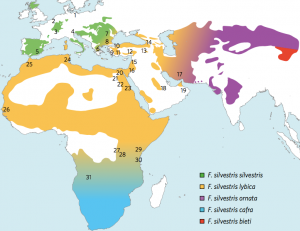“In its simplest form, to domesticate an animal means to tame it, through breeding and training, to need and accept the care of humans.” (Ault, 2015). By this definition, humans have been domesticating dogs for roughly 30,000 years, ever since they diverged from their wolf ancestors and came to rely on their human masters for food, shelter, and companionship (Ault, 2015). Other mammals that are commonly kept as pets or livestock have similar histories of being controlled and selectively bred by humans, with one notable exception. When it comes to cats, the question is not how long they have been domesticated, but whether they have ever truly been domesticated at all.
In 2017, an international team of scientists led by University of Leuven geneticist Claudio Ottoni published the results of a project in which they analyzed the mitochondrial DNA of over 200 cats whose dates ranged from about 9,000 years ago to the present (Newitz, 2017). The team identified two major waves of domestication that contributed to the role of cats in human society today. The first took place in the Fertile Crescent roughly 7,500 years ago, when wildcats from Anatolia started hanging around human settlements due to the presence of mice and rodents (Ottoni, 2017). In a way, these cats domesticated themselves by inadvertently building a symbiotic relationship with humans in farming communities: humans’ crops attracted rodents, and it was beneficial to both parties if cats ate those rodents (Tufts, 2017). By the time of the Mediterranean “classical era,” most ships’ captains kept a cat onboard in order to take care of vermin, which allowed these wildcats to spread along shipping routes (Figure 1) (Newitz, 2017).
The second major wave of domestication occurred during the Greek and Roman periods, when the popularity of Egyptian cats led to a massive migration of cats descended from the North African F. s. lybica to Europe. These Egyptian cats spread as far north as the Baltic Sea and as far east as Iran by the 8th century AD, which significantly increased the presence of f. s. lybica in the overall house cat gene pool (Ottoni, 2017).

Figure 2. A blotched tabby, possibly the first human-created cat breed. Photograph by Vladislav Starozhilov.
Ottoni’s research team did not find evidence of humans breeding cats until the Middle Ages, when the human-created “blotched tabby” (Figure 2) emerged. Compared to domestic dogs, who have been more or less completely controlled by humans for many millennia, humans have been breeding cats for less than 1,000 years (Newitz, 2017). Furthermore, since cats have not been bred as selectively as dogs, they have been able to retain their hunting skills in a way that dogs and other domestic animals have not. In fact, the genes of felis catus (the average housecat) and felis silvestris (the European wildcat) are nearly identical (Ault, 2015). With this information in mind, is it appropriate to call a house cat “domestic” if it is still capable of surviving in the wild on its own?
Additional Reading:
On the cultural history of house cats: https://www.smithsonianmag.com/history/a-brief-history-of-house-cats-158390681/
On the domestication of many species of pets and livestock: https://www.jyi.org/2012-february/2017/9/17/our-furry-friends-the-history-of-animal-domestication
References:
Ault, Alicia.
April 30, 2015 Ask Smithsonian: Are Cats Domesticated? Smithsonian.com. https://www.smithsonianmag.com/smithsonian-institution/ask-smithsonian-are-cats-domesticated-180955111/, accessed November 3, 2019.
Newitz, Annalee.
June 19, 2017 Cats are an extreme outlier among domestic animals. Ars Technica. https://arstechnica.com/science/2017/06/cats-are-an-extreme-outlier-among-domestic-animals/, accessed November 3, 2019.
Ottoni, C.; Neer, W. V.; Cupere, B. D.; Daligault, J.; Guimaraes, S.; Peters, J.; Spassov, N.; Prendergast, M. E.; Boivin, N. L.; Morales-Muñiz, A. et al.
June 19. 2017 The Complex Domestication of Cats. Max Planck Institute for the Science of Human History. https://www.shh.mpg.de/446464/cat-adna, accessed November 3, 2019.
Tufts Catnip.
August 2017 The Domestication of Cats. Cummings School of Veterinary Medicine at Tufts University. http://www.tuftscatnip.com/issues/25_8/feature/The-Domestication-of-Cats-824-1.html, accessed November 3, 2019.



